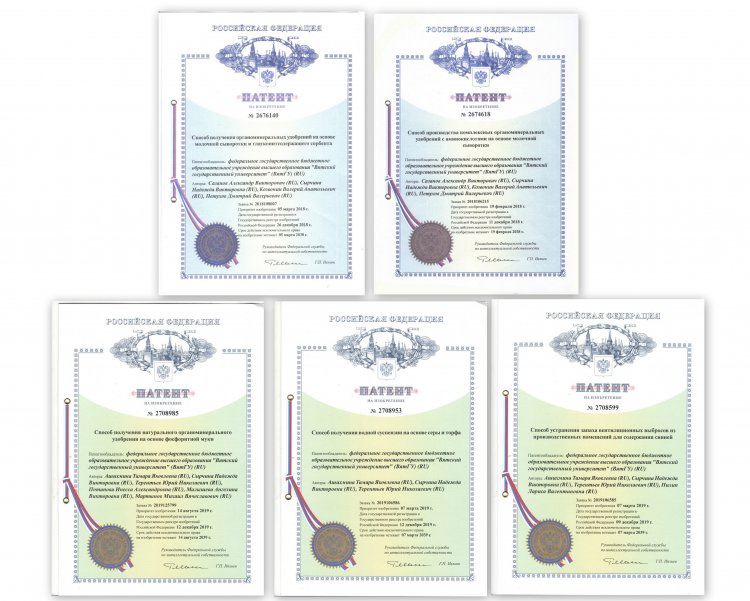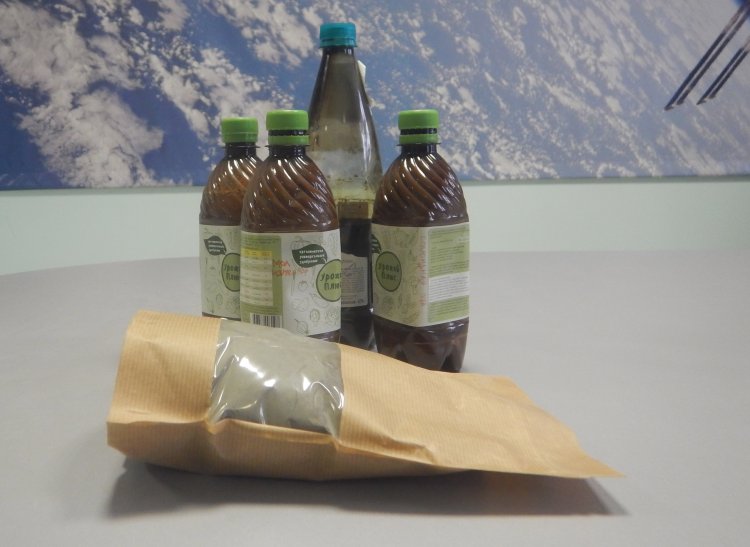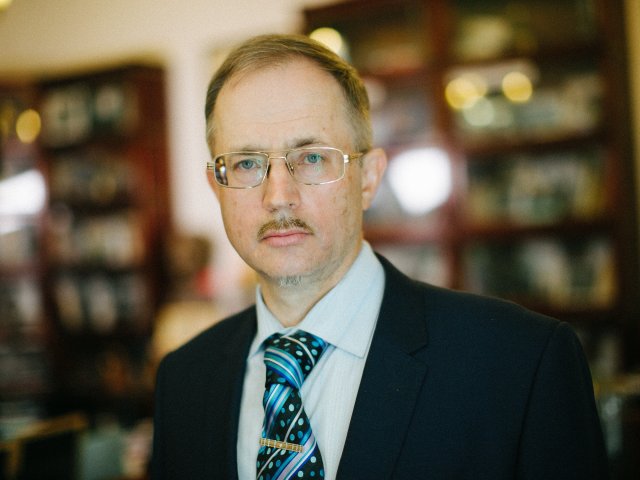Scientists from FRC Komi SC Ural RAS and Vyatka State University are creating promising environmentally friendly and safe fertilizers for organic agriculture using natural raw materials of the Kirov region
The need for phosphate fertilizers in the agro-industrial complex is caused by a significant impoverishment of the soil and a decrease in crop yields. Cropland is contaminated with pathogenic microbes, infested with invasive (non-native) plants, and impoverished. The development of new types of fertilizers (fertilizers-protectors), especially those based on natural organic products, will help to improve conditions for beneficial flora, reduce soil acidity and ensure minimum bioavailability of microelements, and, eventually, to produce clean products with reduced content of toxic or radioactive elements. For example, phosphate rock (minerals that actually are sedimentary rocks) has agrochemically valuable components, which makes it a good candidate for the production of phosphorus-potassium fertilizers with microelements for organic agriculture.
Scientists from the Institute of Biology of the Komi Science Center of the Ural Division of the Russian Academy of Sciences (Syktyvkar) together with their colleagues from Vyatka State University (VyatSU, Kirov) have been conducting long-term research to obtain fertilizers with positive technological indicators based on phosphorites from one of the largest deposits in Russia – the Vyatsko-Kamsky phosphorite-bearing basin. The specialists developed an original recipe for the composition and original technology for processing phosphorite into natural fertilizers, which contain phosphorus, potassium, sulfur and various microelements, vital for replenishing them in the soil. The proposed specialized natural fertilizers for organic agriculture are in demand both in industrial agriculture and among amateur gardeners.
Tamara Yakovlevna Ashikhmina – Doctor of Technical Sciences, Professor at Vyatka State University, Chief Researcher and Head of the Laboratory of Biomonitoring of the Institute of Biology of the Komi Science Center of the Ural Division of the Russian Academy of Sciences (Syktyvkar), Chief Editor of the Journal "Theoretical and Applied Ecology" – speaks about the basis of the unique technology for processing phosphate rock into natural fertilizers created by the research team and the obvious advantages of natural components used for this, as well as pointed out the concerns of scientists engaged in this kind of environmentally friendly fertilizer development in the field of nature management.
The scientific community has accumulated a lot of questions related to the relevance of research work on the creation of new technologies for producing organic fertilizers, especially those based on phosphorites, which is directly related to the problem of general scientific consolidation and mutual assistance. Why so?
"The scientists, including those from our region, have been working in this direction for many years, but their actions and efforts are not coordinated. In other words, each scientific school, laboratory, and individual scientist are advancing in their own way, dealing with a particular direction: some are engaged in bioprotectors, others in micropreparations or organomineral formulations. Therefore, the plenary meeting of the "Kirov Biocluster" in September 2021 proposed (and it was supported by all participants) the creation of a working party that will coordinate the efforts of scientists in the region to promote scientific development projects in the creation and practical implementation of organic agriculture development of fertilizers, first of all, from natural local raw materials. The consortium of universities and research institutes, which may include Vyatka State Agrotechnological University, Vyatka State University, Federal Agricultural Scientific Research Center of the North-East named after N. V. Rudnitsky, Kirov State Medical University, as well as some agrotechnological enterprises in the region, can become the coordinator of all these activities.
In addition, we already have a lot of development projects, but it is difficult to implement them. Apparently, agriculture of today does not have the ability, primarily financial, to support scientific trends in its practice. Indeed, as the Russian Minister of Agriculture Dmitry Patrushev said it right, today we must pay maximum attention to the agriculture, and not only to fertile soils, but to the development of territories that need to increase fertility through the introduction of various scientific development projects, too.
Russia adopted a federal law on organic products and it came into force on January 1, 2020, this document forms the regulatory framework for the production and supply of products in Russia, which exclude the use of traditional fertilizers, obtained by chemical processing of raw materials. However, there is no law on organic farming, as well as there are no by-laws. For example, there are many uncertainties about what constitutes organic products and what list it should include. Enterprises must have "green certificates" and strive to obtain them, but today this matter is extremely underdeveloped. We need a serious scientific approach to address these issues. The words of the Russian President Vladimir Putin that university science should make a significant contribution to the development of this scientific research are true. In this regard, the members of the "Kirov Biocluster" Board have decided to gather scientists from research institutes, universities of Kirov, and business representatives to help agriculture and farming move forward in this direction. I believe that this is a serious task for science.
The need to use fertilizers in the agro-industrial complex is determined by the deficit of plant mineral nutrients in agrosoil. Lack of agrochemically valuable elements leads to a decrease in crop yields and general degradation of agroecosystems. It should be noted that traditional mineral fertilizers are not able to solve the problem of the agrosoil degradation completely. Today, there is a clear understanding that approaches to the organization and management of agriculture require a serious adjustment, especially in terms of compliance with environmental norms and principles. The improvement of the fertilizer system can help to reduce agrogenic pressure on the environment. At present, the leading trend of advanced agriculture is reducing the share of standard fertilizers and switching to the use of "smart" fertilizers, which reduce the intensity of tillage, increase fertility, improve ecological condition and resistance of the agrosphere to natural-anthropogenic pressures. High-tech agriculture requires not only mineral and organic fertilizers, but also fertilizers that meet the requirements of soil-protective agriculture. At the same time, the domestic chemical industry is focused on the production of traditional fertilizers, while scientific research in this industry focuses on solving problems of reducing the cost of production and expanding sales markets. Lack of interest in the development of new promising forms of fertilizers, including those for organic agriculture, leads to a technological gap in the country, both in the production of innovative agrochemical products and in the implementation of new advanced technologies in agricultural production," Tamara Ashikhmina indicated the need to search for technical solutions and existing problems of agricultural land and agrolandscape fertility maintenance.
The research projects of the scientists of FRC Komi SC Ural RAS and VyatSU include two areas: the development of compositions and technology of fertilizers for organic farming and the development of compositions and technology of fertilizers for soil-protective agriculture (defense fertilizers). Tamara Ashikhmina notes that "the main requirement to the developed technologies is as follows: compliance with the principles of "green chemistry," i.e., the minimum amount of waste produced, low energy consumption, low "carbon footprint." We have managed to reach the level of almost zero-waste technology in terms of fertilizers for organic farming.
Scientists are developing fertilizers for organic agriculture based on phosphorites from the Vyatsko-Kamsky deposit, the largest phosphorite ore deposit in Russia.
As Tamara Ashikhmina specifies, "according to available estimates, the global market of organic products is currently the fastest growing market in the sphere of material production. A great interest in organic farming is also shown by the Russian agrarians. The Federal Law "On Organic Products and Amendments to Certain Legislative Acts of the Russian Federation" came into force in our country on January 1, 2020. According to this law, the use of traditional agrochemicals is sharply restricted by national, interstate and international standards related to organic production in Russia. Traditional mineral fertilizers are not included in the list of permitted agrochemicals. Thus, there is a new free niche in today's market of mineral fertilizers, which should be filled with specialized natural fertilizers designed for organic agriculture."
What is the difference in the chemical composition of the phosphorites of the Vyatsko-Kamsky phosphorite deposits that you use? What makes them a promising raw material to be processed into natural fertilizers for organic farming?
"According to our research, the Vyatsko-Kamsky phosphorites are quite suitable as raw materials for the production of such fertilizers. Our phosphorites (in the form of phosphorite powder) are characterized by: a relatively high content of phosphorus available to plants; the presence of glauconite (a valuable soil ameliorant, source of potassium and microelements) in the ore; low content of cadmium and other toxic elements. Both phosphorites and glauconites have agrochemical value. Previously, the only material that was extracted from the ore was phosphorites, while glauconite was dumped into the tailings pond.
We suggest using both components for fertilizer production: phosphorites as a source of phosphorus; glauconites as a source of potassium and microelements that are not only necessary for development of cultivated plants, but also for forming healthy microflora, including an increase in productivity of microorganisms capable of binding atmospheric nitrogen and converting it into an accessible form for plants. This is especially important for the successful implementation of organic farming systems that impose a ban on the use of any form of nitrogen-containing mineral fertilizers. The efficiency of fertilizers can be increased by adding peat, a source of organic matter and humus acids, which are valuable for soil fertility.
The content of Cd in our ore does not exceed 2 mg per 1 kg Р2О5, which is significantly lower than the standards established for organic farming (90 mg/kg P2O5) [GOST R 56508-2015]. The low Cd content significantly increases the export potential of OMU on the basis of Vyatsko-Kamsky phosphate rock and glauconite, since the European Union currently imposes strict restrictions on the possibility of using phosphorite fertilizers with high Cd content," the scientist pointed out the benefits of phosphorites from the Kirov region.
The main purpose of defenders (defense fertilizers) is to protect soils from degradation. According to Tamara Ashikhmina, "soil-protective and soil-improving properties of such fertilizers can be achieved by incorporating additional components into traditional mineral fertilizers, which can solve the following problems: reduce the doses of fertilizers without reducing agrochemical effect; reduce leaching of fertilizers from the root zone of the soil; ensure optimal bioavailability of mineral nutrients (including the availability of microelements) throughout the growing season; reduce or eliminate the effect of soil acidification; minimize the possibility of contamination of the final product with toxic components; optimize conditions for the development of beneficial microflora."
Natural sorbents (glauconite, siliceous opoka, zeolites, etc.), humic substances, chelating and filming agents, hydrophobic additives, enzyme inhibitors, plant growth regulators, anti-stress agents, natural plant protection agents against phytopathogenic factors can be used as components to improve the agrochemical characteristics of fertilizers. The corresponding components are widely used for solving certain problems in agrochemistry, but the possibility and prospects of their inclusion in the composition of mineral fertilizers as obligatory components that provide a set of soil-protective properties are still poorly investigated.
"Our researches in the direction of creation of defense fertilizers include three directions: search, study of properties and prospect assessment of inclusion components providing soil-protective effect in the composition of mineral fertilizers; design of compositions of defense fertilizers; development of criteria for evaluation of soil-protective properties of new forms of fertilizers. The research results obtained new data on the effect of glauconite, silica opoka, silicates, carbonates, humates and other natural materials on the mobility of phosphorus, potassium, microelements and heavy metals in soils.
Let me give you an example: ammonium nitrate is currently one of the most popular nitrogen fertilizers today. It is an effective, affordable fertilizer, but it is explosive and fire-hazardous. In order to eliminate this drawback, ammonium nitrate includes lime in its composition. However, in the presence of lime, this fertilizer decomposes quickly and releases ammonia, which leads to large losses of nitrogen and has a negative impact on the environment. Our studies have proven that the inclusion of glauconite into the composition of ammonium nitrate not only leads to the complete elimination of the danger of fertilizer decomposition with ammonia release, but also to a significant reduction of nitrogen leaching from the soil, completely eliminates the fire hazard of fertilizer, stimulates plant development (compared with pure ammonium nitrate), allows reducing the application rates of fertilizer, provides improvement of soil physical properties.
Moreover, the results of our research have developed a method of obtaining a cheap fire-safe sulfur fertilizer containing ground sulfur and humic components of natural peat (without the use of other stabilizing additives). The paste based on sulfur and peat products is characterized by polyfunctionality and can be used as a soil conditioner, a sulfur-containing fertilizer with humates, a fungicide, an acaricide or an insecticide. The high efficiency of including the appropriate paste in phosphoritic flour to increase the bioavailability of phosphorus has been proved. In general, the complex of studies carried out on the basis of the Scientific Research Laboratory of Biomonitoring shows the feasibility and practical significance of new approaches to the design of fertilizer compositions focused on the production of defence fertilizers that contribute to the reduction of agronomic pressure on the environment and the protection of soils from pollution," Tamara Ashikhmina informed in detail.
The result of the achievements of the Russian researchers was a number of patents for inventions in the field of agroecology. For example, an original method of obtaining organic fertilizer based on milk whey (as it is known, it contains many useful components) with the addition of glauconite was proposed. Very often dairies and dairy factories discharge the remains of dairy products into wastewater and the environment. In this case, the environmental safety will be respected, on the one hand, and on the other hand, the depleted soils of agro-landscapes will receive the missing micronutrients.
There is a patent for the elimination of odor from ventilation emissions from production facilities for keeping pigs. Industrial livestock farming uses air purifiers, but sometimes their cost is high, or ozone and formalin, but even this option is not always effective. Therefore, in order to reduce the concentration of odor-forming and toxic substances in the air of animal housing, scientists have proposed an alternative low-cost option – organomineral fertilizers made of pig manure with the addition of industrial waste. The waste reagents are disposed of together with manure runoff without harming nature.
Now there is an application for a new method of producing a natural organomineral fertilizer based on glauconite-containing tailings.
It is remarkable that all proposed development projects of the Russian scientists are based on valuable and mineral resources of the Kirov region and are cheap and environmentally safe, in contrast to soluble mineral fertilizers.
At the moment, the researchers from VyatSU and FRC Komi SC Ural RAS are working on a relevant direction in the field of organic farming – the study of the carbon footprint. The territory of Kirov region has a rich forest fund and a large number of swamps, so, in order to track greenhouse gas emissions, it is necessary to determine how much carbon dioxide is emitted by industrial enterprises and how much is absorbed by natural resources. "In this regard, we need interregional cooperation and support at the legislative level," Tamara Ashikhmina noted.
Vyatka State University has established an ecoanalytical laboratory accredited for 246 indicators, which allows specialists to conduct detailed scientific research in the field of natural environments and objects, industrial emissions and discharges. Modern high-performance measuring instruments can be used to analyze samples and in air, water, sludge, bottom sediments sampling, etc. The staff of the ecoanalytical laboratory have future plans to become accredited in determining the chemical composition of fertilizers, feed additives, and take part in the certification of agricultural products. "Not every Russian regional university has this level of accredited laboratory, its laboratory equipment and scientific staff," Tamara Ashikhmina pointed out.
Patents for Tamara Ashimina's invention in co-authorship (A. V. Sazanov, N. V. Syrchina, V. A. Kozvonin, D. V. Petukhov, Y. N. Terentyev, L. V. Pilip, I. A. Potapova, A. V. Malysheva, M. V. Martynov).
Is your fertilizer development and recommendations receiving any support or interest from the agriculture and chemical industries?
"Yes, we have such contacts. The enterprises of LLC "Himinvestoil" and CJSC "Vyatka-Torf" receive the liquid fertilizers on the basis of our composites. For example, the enterprise "Vyatka-Torf" has some problems: it is forbidden to use peat as the combustible material now, because it leaves carbon footprint and the enterprise has high capacity and is designed for its processing. It is not easy to enter the market of obtaining substances useful for fertility from peat. And our scientific team offers the company the original recipe of organic fertilizer with the addition of phosphorites, thereby contributing to its functioning.
We also cooperate with colleagues from the southern regions, such as Voronezh and Belgorod, and at their request we prepared a compound fertilizer based on sunflower ash," Tamara Ashimina informed us.
Fertilizer samples (in powder and liquid form) based on the technology of scientists from VyatSU and Komi SC Ural RAS, manufactured at "Vyatka Nadalka" LLC.
Thus, the basis of innovative projects of specialists from VyatSU and FRC Komi SC Ural RAS is placed on the valuable properties of natural sorbents, the use of which allows to create fertilizers with a reduced cost for increasing land fertility and solve the problem of complex wasteless processing of valuable phosphorus-containing raw materials.
*All images are provided by T. Ashikhmina, VyatSU
Photo rawpixel























